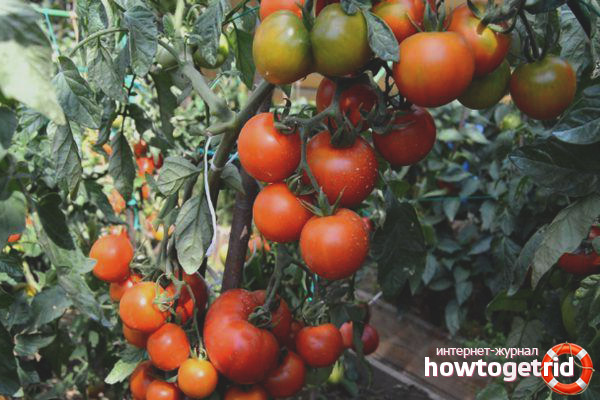The content of the article
From a wide variety of modern tomato varieties, it can be quite difficult to choose suitable for growing. Experienced gardeners periodically replenish their collection with new species, experiment, choosing the best. Tomato varieties Japanese dwarf is excellent for growing on open beds, unpretentious to weather conditions, and has good resistance to fungal infections and pests.
Grade description
The variety is characterized by early ripening and stunted bushes. During the growth, the bushes reach a height of about 50 cm. The plants do not need pinching, which greatly facilitates the work of gardeners and saves time. The bushes, despite the low growth, must be tied to the installed crossbars or pegs.
The shape of the fruit is round, the size is small - up to 70 grams. The first inflorescence is laid over the 6th leaf. Inflorescences are tied with brushes, each with 3-5 tomatoes. When ripening, the fruits acquire a bright red color. The pulp is dense and juicy. The skin is not thick, but strong enough. Tomatoes are great for canning and eating fresh.
Growing Features
Seed should be soaked in water with added salt. Those seeds that appear on the surface must be collected and discarded - these are empty shells. Seeds sown to the bottom are suitable for sowing. Seeds are also recommended to be disinfected with a weak solution of manganese. This will help get rid of fungal viruses and pests.
After all the preparatory procedures, the seeds are laid in the soil, and the container is covered with polyethylene. After emergence, the shelter is removed. As soon as several leaves appear on the growths, they are dived into separate glasses or pots. Landing on open beds is carried out when the temperature is 15 degrees outside. In the prepared wells, you need to make complex dressings. The distance between adjacent bushes should be 30 cm. Tanks with seedlings should be filled with water, then carefully remove the plants from the dishes and place in the hole. After planting all the seedlings, it is necessary to water everything well with warm water.
Care Rules
The normal development of the plants and the yield obtained depend on how care is taken. Tomatoes should be regularly watered with settled water. On hot days, the amount of water should be increased. Loosening the soil and removing weeds will help normalize the full development of the bushes. Particular attention should be paid to top dressing. The first additives should be made a week after planting. The next stage of making nutrient mixtures occurs at the time of beginning fruit set and during fruiting. Top dressing should consist of phosphorus-potassium and nitrogen-containing compounds. Mulching the soil will help reduce the amount of watering, as it helps retain moisture in the ground.
Harmful insects
The Japanese dwarf variety is quite resistant to the invasion of various pests, but for prophylaxis it is necessary to spray the bushes with insecticidal preparations.Such measures will protect plants from dangerous fungal viruses.
The most common pests of the nightshade family are aphids and teddy bears. It is recommended to periodically conduct a visual inspection of the bushes for lesions and insects. If you find a problem, you must immediately take the necessary measures. Sick and diseased leaves must be cut off and treated with a special preparation that can be purchased at any specialized store.
The Japanese dwarf variety attracts the attention of gardeners with its resistance to temperature extremes and unpretentiousness in care. The main advantage of the variety is early ripening. Thanks to this, late blight infection can be avoided. In addition, already in late May or early June, you can try the fruits of their labors. All summer you can cook a variety of dishes with the addition of tomato. Following all agrotechnical recommendations, you can get a rich harvest of smooth yellow and very tasty tomatoes.
Video: Japanese dwarf variety tomatoes










Submit